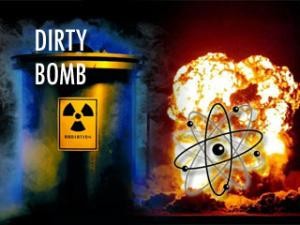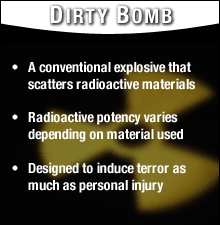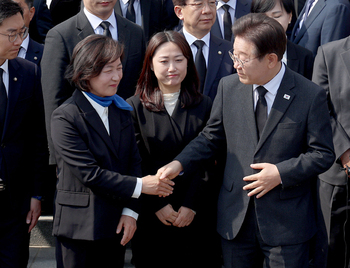-
北, 무인기 활용한 對南 '핵(核)테러' 가능성
“초경량 전술핵 탑재할 수도”... 韓美군사당국
金泌材
韓美군사 당국은 북한이 운용 중인 무인공격기를 더 개발할 경우 ‘더티 밤’(Dirty bomb),
혹은 ‘초경량 전술 핵폭탄’을 탑재할 수 있다고 판단한 것으로 알려졌다. -
‘더티 밤’은 핵폭탄처럼 엄청난 폭발력을 갖추고 있지는 않지만, 심각한 사회 혼란을 일으킬 수 있는 방사능 물질을 포함한 재래식 폭탄이다.불순물을 제거하지 못한 채로 만들어져 글자
그대로 ‘더러운 폭탄’이다. 일정 지역을 장기간에 걸쳐 방사능으로 오염시킬 수 있다.<문화일보> 10일자 보도에 따르면 軍 당국의 이 같은 분석은 북한이 최근 잇달아 ‘핵탄두를 탑재한 무인 타격기로 남쪽을 불바다로 만들겠다“고 위협한 가운데 나온 것이라고 전했다.보도에 따르면 군은 최근 주한미군 관계자 및 전문가들과 함께 비공개로 ‘북한 무인기 대책회의’를 열어 이 같이 분석하고 대책마련에 들어간 것으로 알려졌다.대책회의에 참석한 軍 관계자는 <문화일보>와의 인터뷰에서 “회의에서는 북한이 무인기 성능을 더 발전시키고 핵 경량화 기술을 진전시켜 소형 세슘(Cs-137) 캡슐과 무게 3kg 정도의 폭약을 실은 자폭형 무인공격기를 대도시 상공에서 터뜨릴 경우 엄청난 방사능 피해를 입힐 수 있다는 우려가 있었다”고 밝혔다.참고로 군 당국의 이 같은 우려는 記者가 오래 전 예측했던 내용과 정확히 일치한다. 記者가 판단하건데 북한 軍 수뇌부는 한국군 수뇌부 보다 군사적 측면에서 훨씬 '혁신적 사고'(상상력)를 하고 있는 것으로 여겨진다. 이러한 격차는 한 순간에 좁혀지지 않는다는 게 문제다.아직 전쟁은 시작도 안했다. 북괴가 향후 공개할 비밀무기(?)들이 꽤 많다. 한국군 장성들이 골프를 그만둬야 할 시간이 온 것이다. 軍人이 있어야 할 곳은 골프장이 아니라 戰場이다.김필재(조갑제닷컴) spooner1@hanmail.net[관련 글] 박근혜 정부, 북한의 對南 '복합도발' 대비해야中공산당의 교리를 모방한 북한의 '점혈전략'(點穴戰略)/2013년 4월5일2014년 북한의 對南도발의 유형별로는 ▲천안함 폭침-연평도 포격과 같은 '국지도발'(특수부대를 통한 서해5도 점령) ▲서울 및 인천 공항(항만 포함)등 주요 지역을 타격하는 '고강도 도발' ▲3.20사이버 테러와 같은 '非정형적 도발' 등이다.최근 북한의 對南도발 양상은 중국 공산당의 군사교리를 모방한 ‘점혈전략’(點穴戰略)이다. 인간으로 치면 인체의 급소가 되는 ‘점’(點)을 공략해 상대방을 무력화시키는 전략이다. 가장 많이 적용되고 있는 분야는 역시 ‘사이버전’(Cyber Warfare)이다. 정보시스템의 약점과 급소 부위의 혈(穴)을 눌러 전체를 마비시킴으로써 최대의 효과를 추구하는 것이다.북한의 사이버 전술은 크게 3가지로 다음과 같다. ▲對南 도발 전 악성코드를 남한의 컴퓨터에 잠복-은폐시키는 방법 ▲컴퓨터 인터페이스를 통해 악성코드 침투 후 본 시스템으로 확산시키는 방법 ▲공장에서 컴퓨터를 생산할 때 발생하는 자기장(磁氣場)을 활용해 악성코드를 침투시키거나 또는 간접 자장(磁場)을 만들어 컴퓨터에 장애를 일으키는 방법 등이다.북한의 한반도 공산화 전략에는 변함이 없다. 언제든지 韓美연합군이 예상치 못한 형태의 기습도발을 자행할 것이다. 만약 전쟁이 발발하면 WMD(대량파괴무기)는 물론이고, 전자장비를 무력화시키는 EMP폭탄, 더티-밤(dirty-bomb), 남한의 국가핵심 시설을 해킹해 기능을 마비시키는 등의 非대칭 전력을 재래식 전력과 함께 복합적으로 사용할 가능성이 높다.2013년 ‘3.20사이버테러’ 이후 국내 언론은 사건 배후가 ‘북한과 중국이 아닐 가능성이 높다’면서 정부의 무능을 탓하고 있다. 반면 북한의 對南도발 원점을 타격하겠다던 국방부는 원점도 못 찾고 있다. 이처럼 北의 사이버테러는 ‘남남갈등’을 일으키는 고도의 心理戰이다.북한은 실제 무력(武力)행사를 하지 않고서도 남한 사회를 패닉에 빠트릴 수 있다. 북한의 對南도발능력을 과소평가해선 안 된다. 육해공-우주-사이버 세계가 모두 戰場이다. 상대방은 사이버전 등 첨단으로 도발하는데, 核무기도 없는 남한은 한가하게 총-칼 들고 원점타격하겠다고 한다. 현대전에 전후방은 존재하지 않는다. 절대 경계를 늦추어서는 안될 것이다.조갑제닷컴 김필재 spooner1@hanmail.net -
Definition of a Dirty BombThe United States Nuclear Regulatory Commission (USNRC) defines a dirty bomb as, 'type of a “radiological dispersal device” (RDD) that combines a conventional explosive, such as dynamite, with radioactive material.' Simply put, a terrorist can obtain a regular explosive, such as TNT or dynamite and attach radioactive material to it. Making a dirty bomb is relatively inexpensive and easy. The figure below from CNN, outlines the main points.
-
According to the Centers for Disease Control and Prevention, the primary dangers of a dirty bomb are the physical danger of the immediate blast with the danger of diseases related to radiation exposure being secondary. The CDC speculates that a dirty bomb would only contain enough radiation to cause 'immediate serious illness' in individuals in the immediate vicinity of the blast (CDC, 2006).There are two main components:Conventional ExplosiveThe conventional explosive can be anything that explodes, instructions on how to make just an explosive are readily available. For those who like to read books The Anarchists Cookbook contains instructions on how to make TNT and dynamite. As for those who like the internet, a simple google search will yield many results on how to make explosives from household chemicals. In fact, a simple search on Google for 'how to make a bomb' will turn up 34,100,000 hits in .10 seconds.Examples of a conventional explosive include: TNT, dynamite, C-4, and plastic explosive.Radioactive MaterialThe second part of a dirty bomb is the radioactive material. This is more difficult to obtain. It can typically be some kind of radioactive waste, because it is easy to steal. Radioactive garbage is typically under less security then weapons grade Plutonium. There are many residential, commercial and industrial uses for radioactive materials. For example, nuclear medicine, smoke detectors, etc... However, this is not the real threat, Susan Combs, the Texas Comptroller of Public Accounts writes in her Fiscal Notes, 'These materials vary greatly in the potential danger they represent. Smoke detectors, for instance, contain only tiny amounts of nuclear material, and many radioactive sources used in medicine lose their potency within days or even minutes” (Combs, 1).One way to acquire nuclear material for a dirty bomb, as pointed out by the Chicago Tribune, is from the former Soviet Union. The satellite states of the former Soviet Union are in complete economic disarray. 'Jobless for two years, Gagik Tovmasyan believed escape from poverty lay in a cardboard box on his kitchen floor. Inside the box, a blue, lead-lined vessel held the right type and amount of radioactive cesium to make a 'dirty bomb.' The material was given to him by an unemployed Armenian Catholic priest who promised a cut if Tovmasyan could find a buyer.'The collapse of the Soviet Union came as a big sigh of relief for the United States. But with that collapse came the good, the bad, and the ugly. The good news was that an ideological opponent was wiped out. The bad news was that there was some economic instability which led to disorder. The ugly, is the fact that there are lots of weapons and material that are unaccounted for. Materials that can be very deadly if they were to find themselves in the wrong hands. For example, the suitcase nuclear warheads that the Soviets developed, it appears that a few are lost (do not confuse the suitcase nuclear bomb with a dirty bomb, the suitcase bomb is an actual thermonuclear weapon that is small enough to fit in a suitcase).In the case of Mr. Gagik Tovmasyan, his problem was that he was poor, without a job, and had some Cesium-137. His solution: sell it to make some money. Luckily, Mr. Tovmasyan tried to sell the Cesium to an agent, and ended up in prison. However, nobody is out of the danger, the radioactive material needed is readily available at poorly protected or unprotected bases all over Russia.Lots of radioactive materials disappear and go unaccounted for. Any of them could wind up as part of a dirty bomb. A few examples of acceptable radioactive sources are radioisotopes of: Cesium, Cobalt, or Americium. Americium-241 is found in some household smoke detectors, but it is in a tiny insignificant amount.Below is a selection of possible dirty bomb radioisotopes. However, every element in the periodic table has one or more radioactive isotopes, any radioactive isotope can be used in a dirty bomb. The shortened list below has been carefully chosen because these particular isotopes bear an importance due to their commercial and industrial uses.How it all comes togetherThe conventional explosive detonates, spreading the radioactive material around.The immediate impact of the bomb is felt through the explosion. A slight gust of wind would be enough to disperse the radioactive material into the air (most scientists agree this will have a negliable effect on health). The problem is thatfear and mass panic will ensue. Imagine the number of car accidents and stampedes a bomb, never the less a bomb with 'nuclear tendencies', would cause. People would flee cities clogging highways and bridges, money would be pulled from banks, people would not go to work. This is 'terrorism' at its height.
[조갑제닷컴=뉴데일리 특약]
“초경량 전술핵 탑재할 수도”... 韓美군사당국
北, 무인기 활용한 對南 '핵(核)테러' 가능성
- 김필재
입력 2014-04-11 09:53수정 2014-04-11 13:05
공유하기
기사 공유하기
김필재










